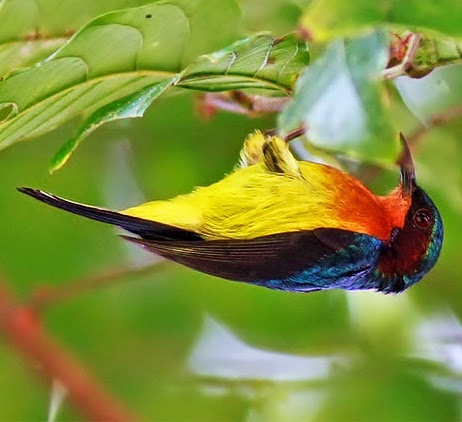 |
| Photo from (OK Nation) |
Common name:
ruby-cheeked sunbird (en); beija-flor-de-faces-rubi (pt); souimanga à joues rubis (fr); suimanga carirrubí (es); rubinwangen-nektarvogel (de)
Taxonomy:
Order Passeriformes
Family Nectariniidae
Range:
This species is found throughout South-east Asia, from north-eastern India and southern China, through Indochina and into the Indonesian islands of Java, Sumatra and Borneo.
Size:
These birds are 10-11 cm long and weigh 8-9 g.
Habitat:
The ruby-cheeked sunbird is found in moist tropical forest and mangroves, including forest edges and second growths, as well as moist scrublands, rivers and streams, plantations and rural gardens.
Diet:
They feed on small arthropods, including caterpillars and spiders, as well as fruits, pollen and nectar.
Breeding:
These birds breed in February-August. They are monogamous and the nest is purse-shaped and made of plant fibres held together with spider webs. The nest is placed hanging beneath the leaves at the end of a branch in a scrub or small tree 1-3 m above the ground. The female lays 2 cream or pinkish eggs with purplish-grey mottles. The eggs are incubated by the female alone, but both parents feed the chicks. There is no information regarding the length of the incubation and fledging periods.
Conservation:
IUCN status – LC (Least Concern)
This species has a very large breeding range and is described as common in Thailand, Sabah and the Indian Subcontinent, locally common in Bangladesh, very rare in Nepal, rare in Bhutan and uncommon on Sumatra. The population is suspected to be stable in the absence of evidence for any declines or substantial threats.







